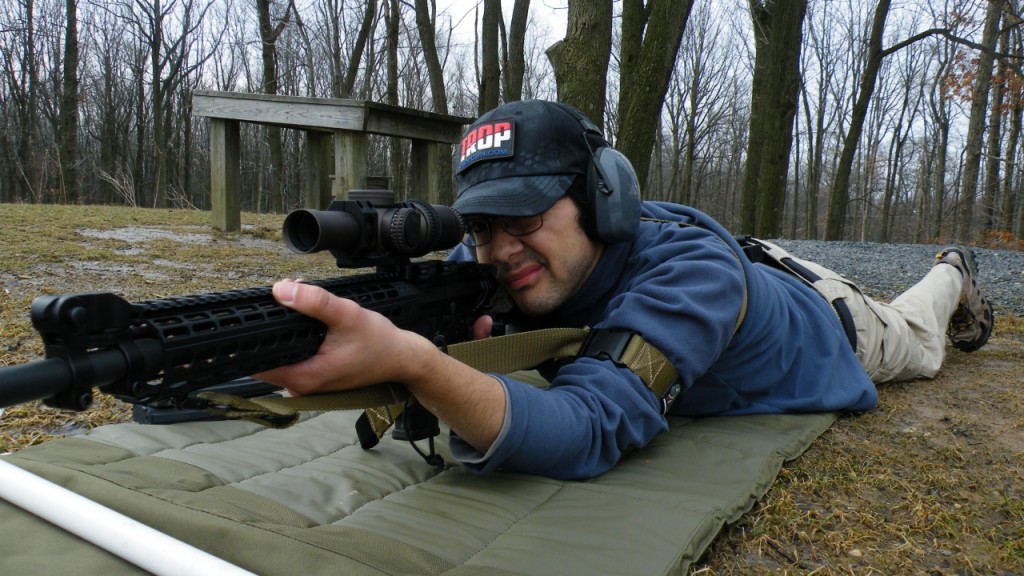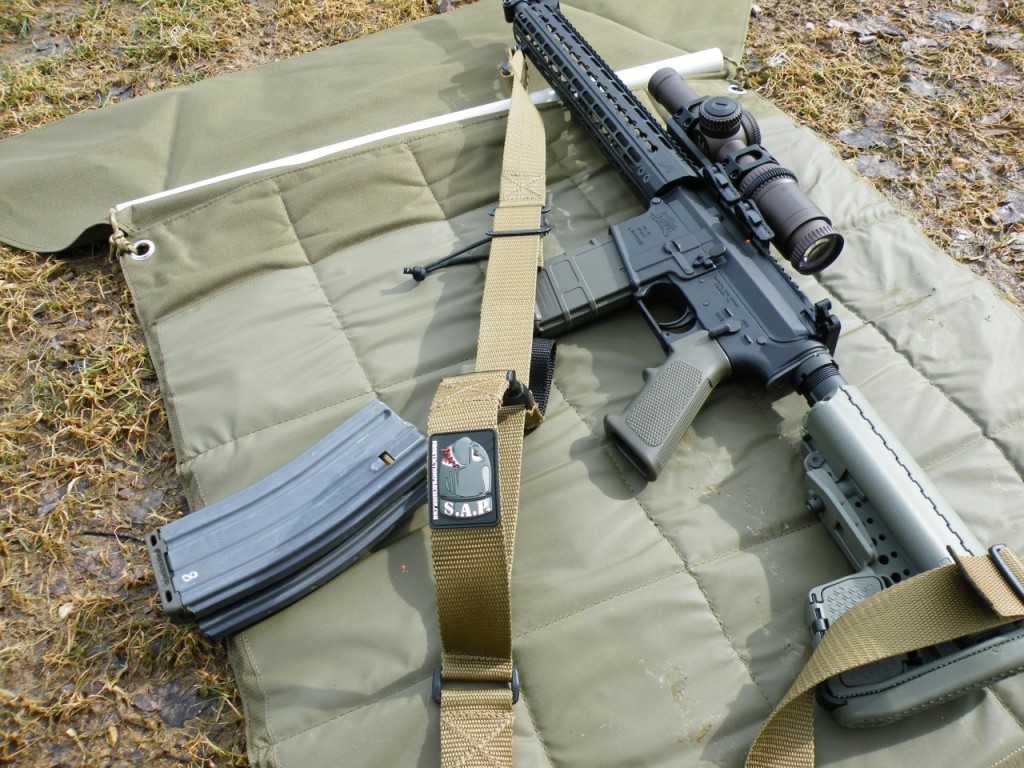I purchased a Short Action Precision Positional Sling, and I am glad I did. Finally, I have a modern shooting sling for my modern rifle. One of the most secure methods of shooting unsupported prone is to use a military style web sling or a turner sling. These items are practical if you have all the time in the world, but are largely impractical in all other aspects.
I wanted a modern shooting sling that allows me to quickly don and doff the cuff, and that gives me the necessary adjust-ability in a easy to use format. I found a good realization of the concept:
The S.A.P. Positional Sling:

All slung up: my next project will be to move the sling swivel midway down the forearm. This will act as a natural hand-stop and moving the elbow closer to the body will reduce the aggressive arm angle and help the sling stay put even better.
The S.A.P. positional sling is faster than other traditional slings such as the turner or USGI web sling. It can be applied while the rifle is still slung on the shooter. It has a restricting cuff built-in and tightens harder the more tension is applied. It has a fastex buckle to quickly doff the arm loop. Ahead of the buckle is a quick adjusting clamp which allows you to further adjust your sling tension. I had to remove some of the powder coating with a small file on the clamp; the thickness of the powder coat dulled the bite and allowed a bit of slippage. Using the file to sharpen the teeth was easy and gave the sling tremendous bite against the webbing.

Muddy day at the range.
I used the sling throughout my range day and enjoyed my time with it. It is well made and secures the rifle in a steady shooting positions just as good as a USGI web sling. The concept of a modern rifle is well suited to having a shooting sling that doubles as a modern two point sling. Just like many other designs, you can shorten it or lengthen the sling with the pull tab, but unlike many others this sling can do double duty to help steady your aim.
Wrapping Up:
Priced in at around 90 dollars, the price is a bit hefty. Like I said in the video, if you are looking at a sling like this, then you probably take your rifle very seriously. Rich, the owner or co-owner, was quick to answer questions and returned my comments promptly. He mentioned that if you ever had any issues with the sling, he would quickly take care of it. I can’t see the sling failing or having any issues as it is simple and well stitched. I will keep readers informed if any issues pop up, but I don’t think they will. Overall, if you want a fast, rock solid shooting sling… give the S.A.P. positional sling a try. It is superior in every way to old USGI slings, and compliments a modern rifle nicely. It’s a great tool to have attached to your rifle.






First sling I’ve seen like this. Color me interested though I’ll wait and hope for a sale at $90 per. I hope you keep us updated on this as you use it, I would really enjoy your thoughts on it after some extended time with it.
Go to RWVA store and buy a very functional classic G.I. sling for less than 15.00 USD. I find them to be every bit as good as anything out there.
They are good and far cheaper than the sling I reviewed, but they are difficult to utilize under pressure and much slower to remove in a pinch. Everyone should have one, but its Achilles heel is the lack of speed.
GI slings are functional on a nice flat range fir qual. In the field they’re mediocre to poor at everything else.
I wonder how hard it would be to add a cuff to a blue force gear sling…hmm
Look up the Ching sling. First-rate use for a hunting rifle, but maybe not for something with a very long protruding magazine. For that, there’s the RS-1: http://rifle-craft.com/shop/
Both of the above are speed loops. Me likey.
Good idea on the sling! Like other commenters have mentioned, there are quite a few options for cuff-style slings. The Cleckner Sling is one; I’ve found two others apart from the one from SAP you’re using here. The Magpul RLS is a $20 simplified sling that works very well in cuff support fashion. And the M1 Garand style sling, “traditional GI sling,” is cheaper than the Magpul RLS and works the same way, but in cotton instead of nylon. The nylon can slide against certain fabrics and some people’s skin; cotton rarely does.
Here’s a good tip for using the cuffed sling in prone.
Get your left elbow (the one connecting to your support hand) as directly beneath the bore axis as you can. You’ll have to adjust your sling (loosened, compared to the photo above) to enable this position. It will help eliminate horizontal patterning/stringing, especially diagonal displacements, resulting from a support elbow that deviates from the bore axis.
If you have a shoulder or elbow impingement that prevents this, then the goal is as near to directly under the bore axis as your anatomy allows.
Proper sling use is slower to deploy than a bipod, but it’s got the benefit of being already attached to your rifle rather than being a new, weighty attachment that only gets deployed occasionally. Done right, a cuffed sling is almost as stable as a bipod. When done properly it’s all skeletal stacking and very little muscle tension. The sling does all the muscle tension work.
If you’ve ever tried to shoot freehand standing, biathlon style, with your support elbow camped above your hip bone, stacking your bones to support the rifle rather than using muscle tension, you know the goal here. Same deal, just instead of finding that proper camping spot on your hip bone, here you want as close to directly under the bore axis as possible.
Elbow padding can help here for those with very bony elbows. And putting the cuff near your armpit, above the bulging part of your bicep, is important for good stability.
Make sure the support hand is not gripping the handguard/forend. It’s a perch, it’s not a grip. Grip will affect your point of aim, and it’s amplified the longer the distance you’re shooting.